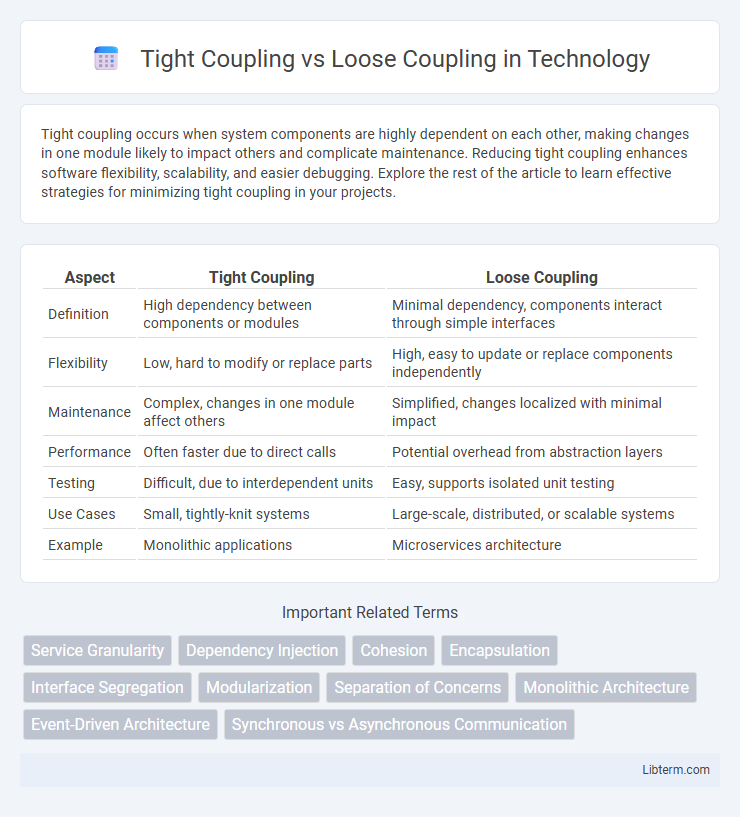Tight coupling occurs when system components are highly dependent on each other, making changes in one module likely to impact others and complicate maintenance. Reducing tight coupling enhances software flexibility, scalability, and easier debugging. Explore the rest of the article to learn effective strategies for minimizing tight coupling in your projects.
Table of Comparison
| Aspect | Tight Coupling | Loose Coupling |
|---|---|---|
| Definition | High dependency between components or modules | Minimal dependency, components interact through simple interfaces |
| Flexibility | Low, hard to modify or replace parts | High, easy to update or replace components independently |
| Maintenance | Complex, changes in one module affect others | Simplified, changes localized with minimal impact |
| Performance | Often faster due to direct calls | Potential overhead from abstraction layers |
| Testing | Difficult, due to interdependent units | Easy, supports isolated unit testing |
| Use Cases | Small, tightly-knit systems | Large-scale, distributed, or scalable systems |
| Example | Monolithic applications | Microservices architecture |
Introduction to Coupling in Software Design
Coupling in software design refers to the degree of interdependence between software modules, affecting maintainability and scalability. Tight coupling occurs when modules are highly dependent on each other, leading to fragile and hard-to-maintain systems. Loose coupling promotes modularity by minimizing dependencies, enabling easier updates and enhancing system flexibility.
Defining Tight Coupling
Tight coupling occurs when software components are highly dependent on each other, making changes in one module likely to impact others and reducing flexibility. This close interdependency hinders maintainability and scalability, as modifications require extensive coordination between interconnected parts. Systems exhibiting tight coupling often face challenges in testing and integration due to their rigid structure and lack of modularity.
Defining Loose Coupling
Loose coupling refers to a design principle in software engineering where components or systems interact with minimal dependencies, allowing each to change or evolve independently without affecting others. This approach enhances modularity, scalability, and maintainability by reducing the need for direct knowledge of internal details between interacting parts. Implementing loose coupling often involves abstraction techniques, interfaces, and messaging patterns to ensure components communicate through well-defined contracts rather than tight bindings.
Key Differences Between Tight and Loose Coupling
Tight coupling involves system components that are highly dependent on each other, resulting in reduced flexibility, increased complexity, and difficulty in maintenance and testing. Loose coupling enables components to interact through well-defined interfaces, promoting scalability, easier updates, and improved fault isolation. Key differences include dependency level, with tight coupling having strong interdependencies and loose coupling featuring minimal dependencies, and impact on system adaptability, where loose coupling allows easier modifications without widespread effects.
Advantages of Tight Coupling
Tight coupling enhances performance by enabling direct and efficient communication between components, reducing latency and overhead. It simplifies debugging and development by providing clear dependencies and interactions, making the system easier to understand and maintain in tightly controlled environments. This approach is advantageous in scenarios requiring fast, reliable integration and real-time data exchange, where closely related modules must work seamlessly together.
Disadvantages of Tight Coupling
Tight coupling in software design leads to reduced modularity, making maintenance and scalability more difficult due to interdependent components. Changes in one module often require extensive modifications in others, increasing the risk of bugs and deployment delays. This dependency also hinders code reuse and complicates testing processes, resulting in less flexible and more fragile systems.
Benefits of Loose Coupling
Loose coupling enhances system flexibility by allowing components to interact with minimal dependencies, which simplifies maintenance and updates. It promotes scalability and easier integration of new features, reducing the risk of cascading failures in software architectures. This approach supports modular design, enabling teams to work independently and accelerate development cycles.
Challenges of Implementing Loose Coupling
Implementing loose coupling presents challenges such as increased complexity in designing interfaces and ensuring consistent communication between independent modules. Managing dependencies and coordinating data flow without tight integration requires advanced architectural patterns and careful planning. Debugging and testing become more difficult due to the distributed nature of loosely coupled systems, demanding comprehensive monitoring and error-handling strategies.
Real-world Examples of Coupling Strategies
Microservices architecture exemplifies loose coupling by enabling independent deployment and scaling of services, such as in Netflix's streaming platform where each feature operates independently. In contrast, a tightly coupled system like traditional monolithic ERP software integrates components deeply, requiring simultaneous updates and limiting flexibility. Automotive systems demonstrate a hybrid approach, where loosely coupled infotainment systems coexist with tightly coupled engine control units to balance modularity and real-time performance.
Best Practices for Achieving Optimal Coupling
Optimal coupling requires designing components with clear, well-defined interfaces to minimize dependencies and facilitate independent changes. Employing techniques like dependency injection and modular architecture enhances loose coupling, promoting scalability and testability. Regular code refactoring and adherence to the single responsibility principle further reduce tight coupling, enabling maintainable and flexible systems.
Tight Coupling Infographic

 libterm.com
libterm.com